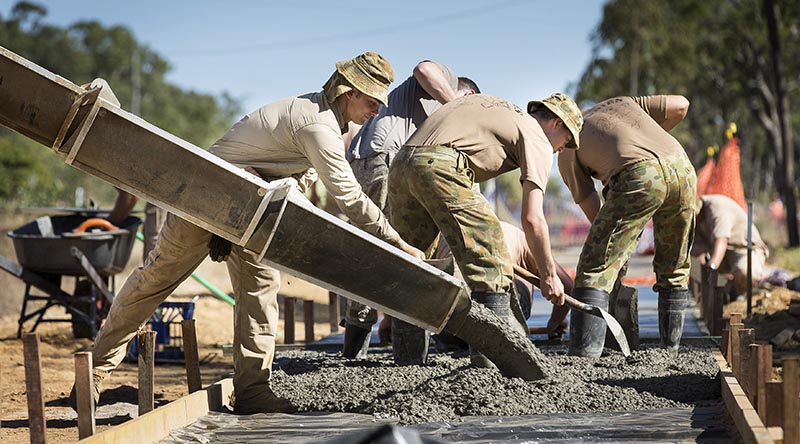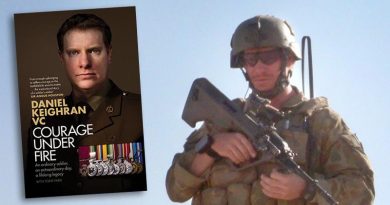Proposal to raise an Army Cadet Apprentice School
Share the post "Proposal to raise an Army Cadet Apprentice School"
Richard Peter Billington
15 Ranleigh Way
Greenwood
WA 6024
16THFebruary 2020
Mr Keith Pitt
Minister for Resources, Water
And Northern Australia
Box 6022 House of Representatives
Parliament House
Canberra ACT 2600
Dear Keith,
Re: Making It Work For The Young (Weekend West 15-16th February 2020)
This exclusive by Lanai Scarr writes / quotes you several times throughout the article, emphasizing your commitment to the employment of Australia’s young both here in WA and across the country.
The feeling of your forceful and unrelenting approach is very clearly conveyed in the article. It really does sound like you can and will make a difference.
So before I put my questions to you in regard to the newspaper article and your work so far, I wish to explain my interest in this topic.
I am the spokesperson for a group of Ex-service persons, who predominately came through the Army Apprentices School system during the 50’s to the 90’s, together with other Ex-Service members of the AAA School Association, Royal Australian Engineers Association of WA, Royal Australian Signal Association (WA Branch), Australian Army Cadet Brigade WA, retired former Program Manager Building Studies Leederville Technical College, and members of Perth Legacy.
We have been trying to make the State and Federal Governments realise that there is a problem in WA and Australia as a whole, in regard to the CAPACITY in Apprenticeship Training. That is, we really cannot believe the State and Federal Governments think, all you have to do is shout louder or put another incentive scheme out there and the problem will get solved.
On the WHOLE there is only ONE avenue to Training and Certification of Qualified Tradespeople who have completed an Apprenticeship and that is the TAFE.
The following is an extract from correspondence we have previously sent to some people and Government Departments including: Defence West via Peter Tinley MLA (Minister for Veterans Issues) and Paul Papallia MLA (Minister for Defence Issues), Mr Ray Sputore member of the State Training Board (Department of Training and Workforce Development), the Governor Kim Beazley and Mrs Gina Rinehart (Hancock Prospecting Pty Ltd).
Apprenticeship training in Western Australia (as for most states), is in our opinion appalling. The TAFE system is not working, is top heavy and does not address the needs of today, in dealing with and training teenagers and young adults.
We believe the existing TAFE system is not capable in many ways. Briefly these inadequacies include:
- It does not train enough Apprentices through to completed Tradespeople
- There is a massive dropout rate with this system
- The overall standard across all Apprenticeships is not good
- Attendance at the TAFE Campuses is on a block basis and does not have continuity of instruction and training (ie: C&J Apprentices will only attend TAFE 2 or 3 blocks of 2 weeks each block)
- Principally all Tradesmen produced and who have a completed trade training certificate under their belts, come through / from the North and South Metropolitan TAFE. Some few also come through the Bunbury, Kalgoorlie, Geraldton and Albany Campuses.
- The mass of all other TAFE Campus throughout the state appear to have little or no success, in producing completed apprenticeships especially in the Building Trades.
- The cost for maintaining and running these Campuses must be enormous.
- The whole set up around TAFE training of Apprentices is a scheme based on Hosting.
- The Registered Training Organisations (RTO) gathers young people under the banner of an Apprentice Trainer when in fact the RTO is just a company keeping the names on young people on a list from which are allocated out to a tradesman when there is the opportunity.
- All the Training, Lecturing, Instructing, Examining is still, ONLY carried out by the Metropolitan TAFE
- TAFE has no capacity to increase the number of Apprentices through this system
Our group is proposing a simple look back in history to see what this country once had and try and emulate that within the constraints of today’s view of handling young people (eg: 15 year olds cannot be Soldiers as we were).
Therefore we are proposing that such a school could be run under the banner of the Australian Army Cadet Brigade and for the point of discussion this proposed college/school could be called, Army Cadet Apprentice School.
The proposal is that we embrace and develop the idea of a High School System that is foremost based on military type rules, principals, discipline, and dedication and above else personal pride and discipline.
And within that military style high school, hopefully assisting to help address some of the perennial problems with today’s teenagers and young adults. Such as:
- Getting enrolments – lack of interest amongst the young to take on a trade
- Retention of enrolled – dropout rate is extremely high and must change
- Helping to overcome the general lack of commitment, discipline, attitude, respect, work ethic, endurance per say, insight to see where a trade can take you in life, concentration (all have iPhone addiction)
- Encouragement of interest in the ADF
- Dual training in an academic/trade and a soldiering/discipline sense
- Retainment and continuity of service as a result
- Leading to young trades people having better and solid opportunities in their lives
The following are quotes, statements and the like from the newspaper article, together with my views or questions:
- The Minister has vowed to fight the growing youth unemployment rate across WA
To vow is ‘a solemn promise/resolve to exact a result’
- Mr Pitt had already begun talks with many of the nation’s largest resource employers
Could it please be known who those companies were and their representative with whom these discussions were with?
- The peak mining body the Mineral Council of Australia will invest one million (A$1m) in new tertiary programs.
This seems a poultry amount of money from the peak body from which great numbers of jobs are going to be available. It would appear they are not on board with your expectations.
- “What I say to each and every resource company is that I expect your doors are wide open for Australia’s youth seeking employment”
These are just words, how are you going to get the mining / resource industry to really act.
- “And if they are not, expect me to come knocking on your door”
And once you have knocked on their door, what?
- “We are creating up to 80,000 Apprenticeships”
This is a staggering statement; if you had said 10,000 it still would have been incredible. Can you please show Australia how this is going to be achieved? Our existing Apprenticeship Training system does not have the capacity to pump out more Tradespeople
- “I want as many of them as possible in regional areas and in the resource sector”
The Minister for Defence Linda Reynolds wants more Indigenous people in the ADF. It would make sense to collaborate with her to set up an Army Cadet Apprentices School solely for Indigenous teenagers and young adults in both the Pilbara and Kimberley regions.
- “I have a loudspeaker I can shout out to the youth of Australia and say there are opportunities for you in the resources sector”
Shouting does not work anymore even footy coaches have given it away. Teenagers, young adults and indeed us all, need to be lead, encouraged and shown the path to these careers, jobs and employment opportunities.
- “I have already had a number of those discussions in the first few days of being in the portfolio”
With whom, where, what did you say, how was the response?
- Mr Pitt said he would visit WA “in the near future” but would not commit to a timeframe
One would think a timeframe for you to implement your stated objectives in this roll, is paramount. Surely it would include scheduled interstate trips.
- Mr Pitt said he would be addressing youth jobs at every opportunity and expected the mining sector to act.
We have an opportunity with our proposal, so can we expect your contribution.
- He would work closely with Federal Employment Minister Michaelia Cash.
Our proposal is equally relevant and important to the Minister for Employment. If at all possible could you both visit WA together? Discussing the pro’s and cons of our proposal with you both would be enlightening and advantageous to everyone.
As we see it, if you really want to make a difference you have to come up with something new in the field of Apprenticeship and Youth Training. We believe our proposition is realistic, achievable and not hard to establish.
When you come west (please don’t leave it too long), it would be nice to meet you and tell you a lot more about our Proposal for an Army Cadet Apprentices School.
Thank for your time and we look forward to your reply.
Yours faithfully,
Peter Billington
Mobile 0419700405
Email: sapperflex@iinet.net.au
.
.
FILE PHOTO (2016): Australian Army engineers pour concrete on an AACAP task. Photo by Sergeant Janine Fabre.
.
.
.
.
.
Share the post "Proposal to raise an Army Cadet Apprentice School"





Well said John and sadly too true. I was in RAEME for 10 years as a Vehicle Mechanic. I then taught in TAFE for 33 yrs and completely concur with all you have said. The same things happened to civvy trades when TAFE changed over to the current system. I wish you luck in trying to get the “Elephant out of the kitchen”
Best wishes
Glenn Read
Victoria
Congratulations on yet another interesting magazine. One of your articles in this magazine addresses the possibilities of an Army Apprentice School. Yes, I was an apprentice for three years at RAAF Base Wagga, from January 1960 to December 1962, graduating as an Armament Fitter. The RAAF Apprentice scheme began in January 1948 and ended in 1993. To be eligible to enter as an apprentice, a boy had to have had his 15th birthday but not his 17th birthday on the day of enlistment, and had graduated from school with a Year 10 pass, (in QLD that was the Queensland Junior Certificate). Therefore, if a person was over the age of 17 years on enlistment, which many were, he went into the Adult Training System. The RAAF Apprentice Training Scheme was a very highly successful scheme, training thousands of young men. Quite a large percentage later studied further and became Air Crew, or Engineering Officers, etc. When the Government of the day announced that the RAAF Apprentice Scheme was to be closed in 1993, there was a HUGE outcry from thousands of current and ex RAAF men and women, as they all agreed that the apprentice scheme was the best training the RAAF had ever seen.
It wasn’t until I read a book titled “From the Ground UP” written by Christopher Coulthard-Clarke, which was a very good description of the RAAF Apprentice Scheme. In the book he gave a very detailed description of the development of the scheme, its growth and eventually its demise. To illustrate his accuracy, he actually names every apprentice who graduated, their intake number and the year they graduated! However, toward the end, he explains one of the reasons the scheme was ended.
In the early years from late 1940s up to perhaps the mid 1970s, most young men who wanted to become a tradesman left school at around Year 10, or about the age of 15, and sought an apprenticeship in their desired trade. Also, most of the young men who went on in their schooling to Year 12 or to the age of 17 or 18, were those who wanted a tertiary degree in their chosen profession. Therefore, it made sense to attract young boys who were between 15 and 17 to start an apprenticeship in several of the aircraft trades. Throughout these years, most of the RAAF aircraft were reasonably straight forward in their technology and not difficult to learn. Even up to the late 1970s, even the new aircraft like the P3-C Orion and the F111C had only started to become reasonably high tech. Therefore, any tradesman who graduated from Apprentices and was posted to one of those units, would, on arrival commence a ‘type’ course on the aircraft applicable to his trade.
However, through the years, as the aircraft became more and more high tech, the RAAF were seeking men and women with a higher standard of education, particularly in Mathematics and Physics. The aircraft type courses were becoming more technical and more difficult. So, prior to cancelling the apprenticeship scheme, they upgraded the adult training scheme to become Aircraft Technicians, or Avionics Technicians, or Weapons Technicians, and the entry level was minimum Year 12. So, they then cancelled the apprentice scheme and all technical entries were a minimum age of 17 and to have Year 12 or better.
Also, at the same time, the six technical trades of Airframe, Armament, Engine, Electrical, and Instrument Fitters, plus Radio Technicians became just two like the Commercial Aviation. Aircraft Technicians were drawn from Airframe and Engine Fitters, and Avionics Technicians were drawn from Electrical, Instrument Fitters and Radio Tech Air. A few years later, they introduced the Weapons Technicians as they realized they couldn’t do without the Armourers! The new ‘Weapons Technicians included several of the new high tech weapons systems of the modern aircraft, modern missiles, etc. When they sent 75SQN with their F18 Hornets to Iraq in 2003, that was the first term of ‘Active Service’ with the new ‘Technician’ people, but it nearly all fell apart as they didn’t realize that they still needed Armourers. Fancy going into Active Service without any Armourers! Very quickly the new “Weapons Technicians” courses were drawn up.
So there, you have a brief history of how the RAAF Apprentice Scheme gave way to the new Technicians. However, if the Army can once again introduce an apprenticeship scheme, it would be an outstanding success. The value of the training received during apprenticeship was without equal in terms of discipline, administration and teamwork. So, try to get hold of a copy of that book:
“From the Ground Up” by Christopher Coulthard-Clarke.
Keep up your good work.
Kind Regards,
John Clarkson.
Good input to the debate John. Thank you.
I was not an Army Apprentice. I was an Adult Trade Fitter Armourer in RAEME. The trade training I received was AWESOME. It was pretty stressful constantly rolling from an Enabler project that you had to pass to the Terminal for whatever stage you were learning such as hand fitting and then machining as these tests were close together on the overall timeline. The design of RAEME Trade Training is simply superior to TAFE Training. I can say this as I attended TAFE to gain advanced trades qualifications in the subjects that Army couldn’t grant me. I’m now giving back and I’m a Second Lieutenant ACS in the Australian Army Cadets. I think Australia’s Youth would love a style of The Army Apprentices Scheme.
I say – bring it on! Or as the AAC say: All IN.
Regards – Chris Hodge 1/91 ATFA and retired SGT Tiffy.